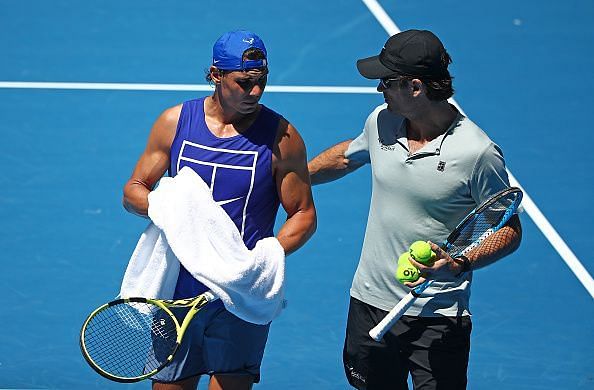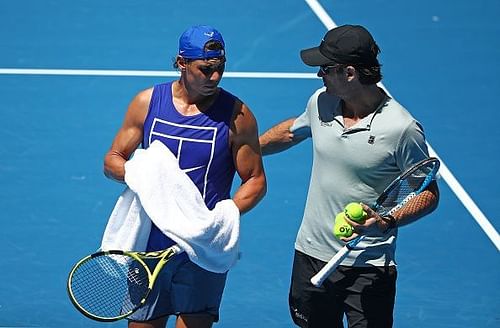
The significance of Carlos Moya in the resurgence of Rafael Nadal

At the end of 2016 season, Rafael Nadal’s win-loss scoresheet of 39-16 for the season wasn’t impressive, at least as far as Nadal’s superlative, superhuman standards are concerned.
And there was no doubt that there was not only a dip in his fitness but also a massive dip in his performances on the court. He had crossed the age 30 mark, his body crumbled more often than before and the transition from one surface to another was becoming increasingly strenuous with every passing tournament.
Rafa in his on-court interview after his 2nd round match at the Australian Open just a few days back said “there’s always one important thing in this life, if things are working, don’t change it. If things are not working, change it”. And following the two dismal years plagued by injuries, shock defeats and performances not up to his mark, the change was inevitable.
And this journey of change was embarked upon by the addition of fellow Spaniard and his long-time friend Carlos Moya to his coaching team just at the end of 2016 season. And that set the tone for remodeling of Rafael Nadal as a complete player. And the move to add Moya to his team paid huge dividends almost right away as Rafa found a place in Australian Open final of 2017.
Though he lost the final to his friend and rival Federer, Nadal was back to his best, where he belonged brushing aside the jadedness that he carried almost throughout the previous year. His complete domination of the clay season of 2017, which included the titles at Monte Carlo, Barcelona, Madrid and the La Decima at the French Open was a testimony to the positive influence Moya was having on Nadal’s overall strategies and the game itself.
The most significant change that we came across in Nadal’s game in 2017 season was his rediscovered aggression. Rather than waiting for the opponent to commit mistakes and stick to a tight defensive game from behind the baseline, Rafa was keen on finishing points, either by rushing to the net or at times by going for the winners.
These tactics helped Nadal to put on clinical performances in 2018 season too as he finished the season with an impressive 45-4 win loss record which included five titles and almost complete domination of clay season once again. However, despite all these victories, Nadal’s physical game took a heavy toll on his body as he missed out most of the hard-court season not only at the start but also at the end of the year.
His nemesis, his poor service, as it has been the case throughout his career, was letting him down once again. At this age, where he has to micromanage his body, an inefficient serve was accompanied by spending long hours on the court, failing to score those easy service points and all these eventually lead to constant wear and tear of body and less time to recover between the matches.
If Rafa has to prolong his career, it is highly imperative that he needs to have an effective serve and realizing just this, Carlos Moya was influential in re-engineering Rafa’s serve before the start of this season. And going by what we came across at the Australian Open so far, it is safe to say that the Moya-Rafa duo have done a fantastic job, as not only the serve speed has improved but also it has become much more potent and lethal than ever before.
And if you have a look at the stats for Rafa’s service games before and after the remodeling of his serve, there’s a difference of broad daylight in between the number of aces per match just to start with. Just as an example, Nadal had 11 aces in his Australian Open quarter-final clash against Frances Tiafoe in just 3 sets while he had as low as 3 aces across long grueling five sets against Juan Martin Del Potro at last year’s Wimbledon quarter-final. This welcome change will not only ensure shorter points but also make Rafa less susceptible to injuries going forward.
There’s absolutely nothing to take away from Rafa’s uncle and longtime coach Toni Nadal for what he has done over the years but arrival of Carlos Moya as Nadal’s coach has just seemed to liberate Rafa from the past pressure as he looks to enjoy himself much more, knowing exactly what works for him and what doesn’t. If indeed Rafa manages to go on for two to three more years, winning a couple of more Grand Slams enroute, Moya surely deserves praise and appreciation for presenting the tennis fans with Nadal version 2.0.